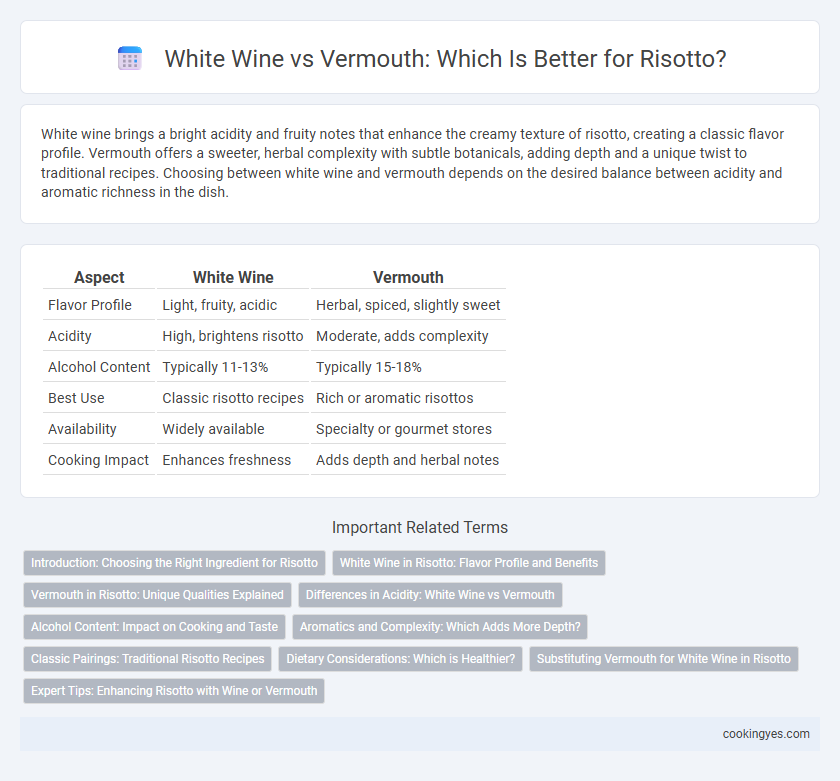White wine brings a bright acidity and fruity notes that enhance the creamy texture of risotto, creating a classic flavor profile. Vermouth offers a sweeter, herbal complexity with subtle botanicals, adding depth and a unique twist to traditional recipes. Choosing between white wine and vermouth depends on the desired balance between acidity and aromatic richness in the dish.
Table of Comparison
| Aspect | White Wine | Vermouth |
|---|---|---|
| Flavor Profile | Light, fruity, acidic | Herbal, spiced, slightly sweet |
| Acidity | High, brightens risotto | Moderate, adds complexity |
| Alcohol Content | Typically 11-13% | Typically 15-18% |
| Best Use | Classic risotto recipes | Rich or aromatic risottos |
| Availability | Widely available | Specialty or gourmet stores |
| Cooking Impact | Enhances freshness | Adds depth and herbal notes |
Introduction: Choosing the Right Ingredient for Risotto
White wine is the traditional choice for risotto, valued for its crisp acidity and fruity notes that enhance the dish's creamy texture. Vermouth offers a unique alternative, bringing herbal complexity and subtle sweetness that can deepen the flavor profile. Selecting between white wine and vermouth depends on the desired balance of acidity and aromatic intensity in the final risotto.
White Wine in Risotto: Flavor Profile and Benefits
White wine in risotto imparts a bright acidity and crisp fruitiness that balances the creamy texture of the dish while enhancing the subtle flavors of Arborio rice and Parmesan cheese. Its moderate alcohol content helps to deglaze the pan and release complex aromas, enriching the overall taste profile without overpowering the ingredients. Using dry white wine varieties like Pinot Grigio or Sauvignon Blanc adds a refreshing tang and depth, elevating traditional risotto recipes with nuanced layers of flavor.
Vermouth in Risotto: Unique Qualities Explained
Vermouth enhances risotto with its complex herbal and botanical flavors, offering a nuanced depth that white wine typically lacks. Its slightly sweet and spiced profile balances the richness of Arborio rice and Parmesan cheese, creating a layered taste experience. Using dry vermouth in risotto introduces subtle aromatic notes that elevate the dish beyond traditional preparations with white wine.
Differences in Acidity: White Wine vs Vermouth
White wine typically offers a crisp acidity with bright citrus and green apple notes, enhancing the risotto's flavors without overpowering its creamy texture. Vermouth presents a more complex acidity, often accompanied by herbal and slightly bitter nuances due to its fortified and aromatized nature. This difference in acidity influences the final taste profile--white wine delivers a clean, fresh tang, while vermouth adds depth with subtle bittersweet and aromatic layers.
Alcohol Content: Impact on Cooking and Taste
White wine typically contains 11-14% alcohol, which evaporates during cooking, contributing acidity and fruity notes that enhance risotto's flavor. Vermouth, with a slightly higher alcohol content of around 15-18%, adds complex herbal and spiced undertones, intensifying the dish's aroma and depth. The alcohol content in both liquors evaporates sufficiently, but vermouth's concentrated flavors often result in a richer, more robust taste profile for risotto.
Aromatics and Complexity: Which Adds More Depth?
White wine imparts crisp acidity and bright fruity notes that enhance the risotto's base flavors with subtle citrus and floral aromatics. Vermouth, infused with botanicals like wormwood and herbs, introduces a complex layer of herbal and slightly bitter nuances, elevating the dish's aromatic profile. The choice depends on whether a cleaner, fruit-driven brightness or a richer, herbaceous depth is desired to add more complexity to the risotto.
Classic Pairings: Traditional Risotto Recipes
Classic risotto recipes traditionally call for dry white wine, such as Pinot Grigio or Sauvignon Blanc, to enhance the dish's delicate flavors with subtle acidity and fruitiness. Vermouth, though less common, can add a unique aromatic complexity due to its botanicals and slight sweetness, making it an intriguing alternative for richer, more robust risottos. Mastering the choice between white wine and vermouth allows for nuanced taste profiles that complement ingredients like mushrooms, seafood, or saffron in traditional Italian risottos.
Dietary Considerations: Which is Healthier?
White wine offers antioxidants such as resveratrol, which may support heart health, while vermouth contains added sugars and botanicals that can increase calorie content and affect blood sugar levels. For individuals managing diabetes or aiming for lower sugar intake, white wine typically represents a healthier choice due to its lower sugar concentration. However, those avoiding alcohol altogether should consider alcohol-free alternatives or vegetable broth to maintain dietary goals during risotto preparation.
Substituting Vermouth for White Wine in Risotto
Substituting vermouth for white wine in risotto introduces herbal and slightly bitter notes that complement the creamy texture while maintaining acidity essential for balance. Vermouth's aromatic botanicals enhance depth and complexity, providing a unique flavor profile compared to the fruitier, crisper taste of dry white wine. Using dry vermouth with moderate sugar content is ideal to avoid overpowering sweetness and to achieve a harmonious risotto.
Expert Tips: Enhancing Risotto with Wine or Vermouth
Choosing between white wine and vermouth for risotto depends on desired flavor depth and acidity; white wine typically offers a clean, bright acidity that balances rich ingredients, while vermouth introduces herbal and slightly sweet notes. Experts recommend dry white wine for classic risotto recipes to enhance umami without overpowering, whereas vermouth can add complexity and aromatic layers to experimental or vegetable-based risottos. Using quality, dry varieties of either wine or vermouth ensures acidity and flavor integration, crucial for achieving the perfect creamy texture and balanced taste.
White Wine vs Vermouth for Risotto Infographic

 cookingyes.com
cookingyes.com